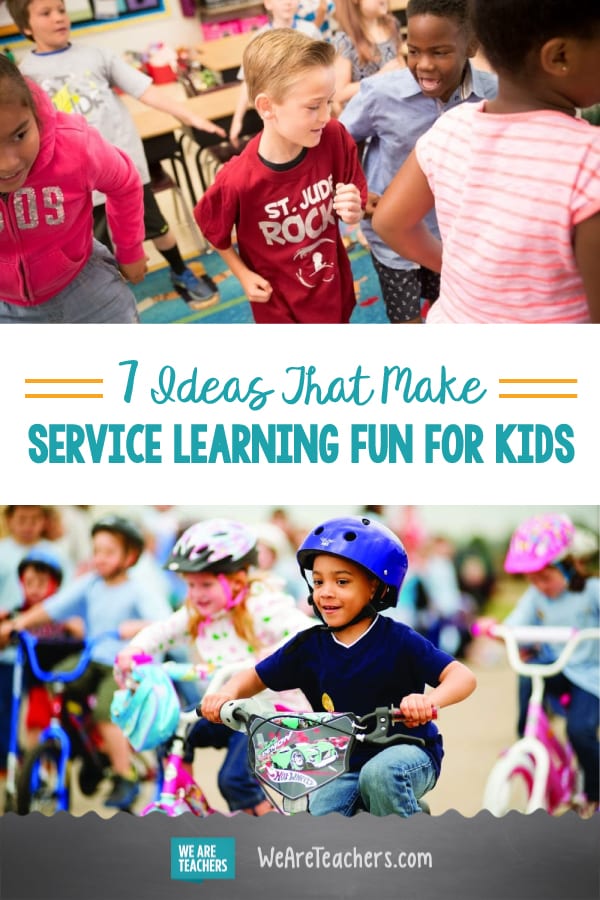“By engaging in service learning with your students, you are doing nothing less than changing the world for the better.”
—Katy Farber from Real and Relevant: A Guide For Service and Project-Based Learning
Service learning empowers students to begin to solve problems in their own communities, or even globally. It is a student-driven process in which students learn about a particular issue, place, or problem. Then, they figure out how to take action in a positive way.
Service learning is closely related to project-based learning in that both embrace these essential elements:
- Driving question: Each unit centers around a high-interest question tied to curricular goals that anchors the entire project.
- Entry event: The entry event is an engaging opening to the project. A few examples include taking a field trip, reading a book, doing a role-play, or listening to an expert.
- Student Research: This is the meat and bones of project-based learning. Depending on the age of students, teachers can provide significant planning and guidance.
- Reflection: In order to connect to learning targets and goals, frequent reflection needs to happen and has to be deliberately built into the schedule. A few examples of ways to facilitate reflection include exit tickets, journal entries and artwork.
- Culminating Event: The culminating event is a public presentation of student work for the school and community. A few examples include exhibitions, presentations, videos, and events.
The main distinction between service learning and project-based learning is the emphasis on service that mutually benefits both parties. With project-based learning, there may or may not be a service component. But according to Faber, “both are incredibly motivating, dynamic, and transformative practices for teaching and learning.”
Some things to keep in mind about engaging in service learning:
You’ll need time
“It can’t be an add-on to curriculum.” Farber explains, “It has to be embedded and integrated for it to work with busy teachers and a full curriculum.”
The prize is in the process
It builds in reflection, takes weeks or months and culminates in a community celebration.
Students are at the center
Students take the lead as they do the research, create, build, solve problems, and take action. Students are the leaders and teachers provide guidance.
It has relevance
Everyone wants to know that their work matters and that there is a greater meaning to it. Project-based learning and service learning give students relevance for their learning because it is rooted in their own communities and helps to solve complex problems.
The benefits
According to Farber, “Students are looking for real and meaningful interactions with the world around them. Service learning gives students more reasons to show up, try, and stay in school.” Some of the very tangible benefits of service learning include:
Standardized testing gains
According to the National Service Learning Clearinghouse (2008), service learning helps academic improvement and higher order thinking skills. This leads to improvements in standardized test scores.
Improved GPA and attendance
Service learning can provide meaning and motivation for students to show up and care about their work. This counteracts the students who are disconnected and disenfranchised with schools and learning.
Improvements in positive behaviors and attitudes
Kids tend to dig more deeply and expand their interest in learning to a wide array of subjects when they feel positive. They make connections and apply learning to other problems. They learn how to collaborate and their social skills improve.
Reduced dropout rates
Students who feel noticed, known and included in their communities feel more valuable and important. This leads to more confidence, greater social skills and a sense of inclusion that counteracts the isolation adolescents feel. According to a study by Bridgeland, DiIulio, & Wulsin (2008), 53% of at-risk students believed that service learning could have a big effect on keeping dropouts in school.
Civic responsibility
Students who participate in service learning gain knowledge about the world around them. As a result they feel empowered to not only participate, but change and improve their community.
Community connections
Service learning can lead to invaluable relationships with people beyond students’ usual realm. Connecting students with local experts, elders, and other members of the community cultivates an expanded world view. Conversely, service learning can break stereotypes and improve the reputation of schools and students in the eye of the community. When you have a team of students actively working to solve problems and improve their community, the results are more connection and respect all around.
